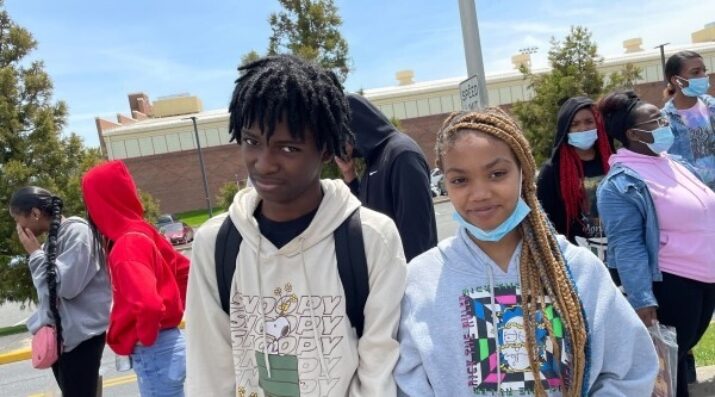New Designs for School
The Most Important Skill We Need to Teach Right Now
Topics

We’ve all had the experience of truly purposeful, authentic learning and know how valuable it is. Educators are taking the best of what we know about learning, student support, effective instruction, and interpersonal skill-building to completely reimagine schools so that students experience that kind of purposeful learning all day, every day.
Teaching students the skill of listening (not the absence of talking) is challenging but necessary for building community and connection.
Every day at the Workshop School begins with circle. Students spend half their day in cohorts of 15-20 students called advisories. It’s where they do all of their project work, but it’s also their “school family,” a close-knit group that spends a lot of time together and gets to know each other well. Circle is the glue that holds it all together. It’s where we check in with each other, learn about one another’s lives, or unpack stuff that’s happening in school, the community, or the world. Sometimes it’s light and fun, other times it is deadly serious. We think of it as a sacred space where community and real-world learning merge into one connected experience.
If only our students saw it that way.
Much as I hate to admit it, a lot of our students see circle as a waste of time. Who wants to spend all that time just…talking? And besides, it’s not even graded!
When circle falls apart as a school ritual, it’s often because the teacher is turning cartwheels to try and make it work and students just aren’t feeling it, which discourages the teacher and makes them less invested in circle, which students in turn pick up on. It’s a vicious cycle.
There are a lot of reasons why rituals like circle are hard to pull off. But there is an underlying factor that not only affects circle but every community space, in every school or organization, anywhere you go. It’s the same thing that’s driving political polarization and truly alarming increases in students’ feelings of isolation and loneliness.
We don’t listen to each other. And in many cases, I’m not sure we know how to.
Think about the last time you felt like someone really listened to you. (If you’re lucky it’s pretty recent, but for a lot of people, especially young people, it may require some effort to call that memory to mind.) It makes you feel valued, worthy. It creates a connection between you and the listener, and just as important, a sense of reciprocity. It validates your presence in a space, a conversation, or a relationship.
Now consider what it feels like when you are not listened to. When your voice is met with distracted concurrence, or is misunderstood due to lack of attention, or when you are ignored altogether. It’s a rejection, a message that you don’t matter or are not welcome. It hardens you, makes you not want to share your voice. It weakens trust and connection. It tells you that you are not safe.
The place we need to start is by first modeling, and then teaching, real listening.
Have you ever tried to teach listening? I mean real listening, not listening as the absence of talking, which is what most schools really mean when they ask students to be “good listeners.” The most striking thing about teaching listening is that it is almost uncomfortably intimate. Try sitting across from a stranger, asking them a question about their life, and then holding eye contact, in silence, while they answer you fully, only then acknowledging and perhaps responding to what they said. Things move from superficial to intense pretty quickly.
Think about the power of putting a group of people in a circle, facing each other, each person fully, deeply listening to their peers. Imagine the reciprocity, the sense of connection and belonging. Who would not want that connection, that enveloping? (Side note: deep listening also provides a way for introverted students to fully engage.)
If we are being honest, most of us guard our attention jealously, constantly evaluating what percentage of it any given interaction (or meeting, or worst of all, mandated professional development) deserves. We think of attention as an investment when we should see it as a gift. We rarely give anyone, or anything, our full attention. We need to do it more often, for our sake and for theirs. We all need the practice.
Listening is a lot harder than one might think. You have to quiet your own mind. You can’t really tune into what someone else is saying if you are channel flipping in your own head. Even in discussions that feel lively and engaged, participants are often so consumed with what they want to add to the conversation that they forget to notice what others are contributing. Listening is also a physical act requiring eye contact, breathing, and attentiveness to nonverbal cues. And then there’s the matter of taking the time to really process what another person is saying, and then showing, in word and in deed, that you have done so.
When I first started thinking about how to fix circle, I immediately went to the themes or questions we chose, the norms we adopted, the way in which the conversation was facilitated, or even what time of day we chose to hold it. It’s possible all of those things could make a difference. But the place we need to start is by first modeling, and then teaching, real listening. Our students deserve each other’s full attention and affirmation. When they know that they will be able to give and receive it, I think we’ll stop hearing that circle is a waste of time. And we will all be healthier and happier for it.
Photo at top courtesy of Workshop School.




